#condylostylus
Text
anyways unrelated to the last post, Condylostylus mundus my beloved. please hold still for me this year so I can get good pictures of you. you're so pretty.
It's a tiny little fly that's iridescent royal blue.
Here's a picture I got last year:

[ID: A photograph showing a raised garden bed, with the focus on an iridescent dark blue fly sitting on the leaf of a bean plant. Its head and abdomen are dark blue, and the thorax is lighter, almost cyan. End ID.]
#pretty sure I'm remembering insect anatomy correctly.#insect photos#bug photos#fly photos#flies#bugs#insects#Condylostylus mundus#Condylostylus#Dolichopodidae#Sciapodini#Sciapodinae#Long-legged Flies
190 notes
·
View notes
Text


Condylostylus sp.
#apologies for my fingers my camera wouldn’t focus on it otherwise#flies#long legged fly#nature#original photographers#insects#entomology#condylostylus#Sciapodinae#Dolichopodidae#diptera#american species#my photos
17 notes
·
View notes
Photo
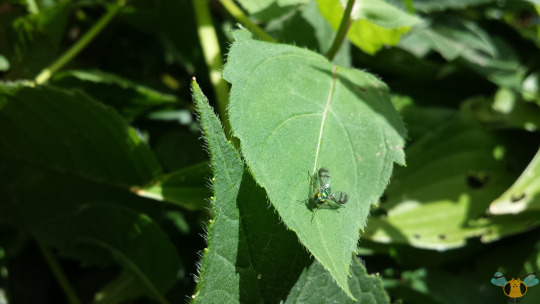
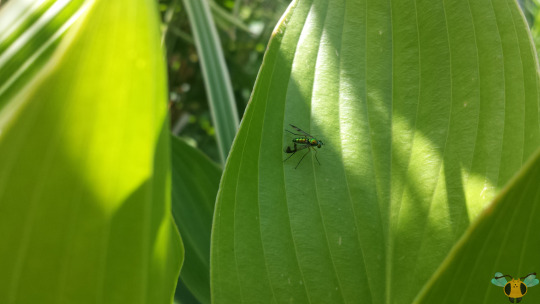




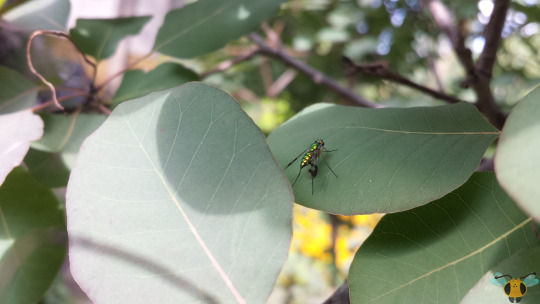



Longlegged Fly - Condylostylus spp.
Over a year later, and still I’ve barely scratched the surface when it comes to these iridescent beauties. It did give me the chance to go through my back catalogue and discover that I have pictures of specimens dating back to 2017, a time when I was very green with these insects (pun intended, I regret nothing). Even from a brief glimpse throughout the years, there’s a lot of variety on display, potentially different species within the Condylostylus genus. Alas, as mentioned in the first post showcasing Longlegged Flies, identification down to the specie is difficult with live specimens and close inspection of their bodies. Having said that, there’s still much that can learned and appreciated from these Flies. For one, the beautiful shimmering greens across the exoskeleton with some individuals having a blend of red and at least one particular individual with a blue tipped abdomen. Would you look at that, they’re Christmas-colored Flies! The color variability also extends to their eyes with some having green and others red and some eyes also appearing more as a blend. For such small Flies, they sure know how to catch the eye, and though their eyes can be different colors, that doesn’t change how these Flies see the world.
The preferred choice of environment can be glimpsed from these pictures. Specifically, I’ve found a majority of this Fly family perching and then scampering on vegetation, but specifically vegetation within a shaded area. Obviously they need a little bit of sun for extra warmth, but they would always tend to run back to the shade and explore that area rather than venture out into the sun. This is consistent with what sources and Bugguide mention, but they also mention that (no surprise here) their preferred environment needs a nearby water source since their young flourish in moist soil. Assuming they’re able to tolerate the Ebony Jewelwings that live by the stream, perhaps they fly to the neighborhood in search of soft-bodied insects. Gardens tend to make a lot of those, and it’s much easier when friendly neighborhood insects perform their own ecosystem control. If they don’t live by the stream in my area, then the soil developing larvae are likely very reliant on rain and watering plants with the hose during the summer months. The winged adults are luckier since they can obtain their nutrients from the insects they pierce. They’ll need all the energy they can get as adulthood for a Longlegged Fly means mating rituals. There’s a bit of that going on in some of these images, but not quite mating pairs yet. There’s a selection process to pass, and the wings and legs have to be in top form!
Pictures were taken on June 24 and August 31, 2017; July 29, 2018; June 18 and 29 & July 7 and 25, 2019 with a Samsung Galaxy S4
#jonny’s insect catalogue#ontario insect#fly#longlegged fly#condylostylus fly#condylostylus#diptera#insect#toronto#2017#2018#2019#entomology#nature#invertebrates
1 note
·
View note
Text
I see at least one cool bug a day, and usually many more, but it’s not because I live anywhere particularly rich in strange, wonderful creatures (I live in an unremarkable corner of Pennsylvania, USA) or spend all of my free time looking for bugs (well, just *most* of it). in my experience, finding interesting bugs is less about actually locating them and more about looking closely at tiny things you’d otherwise ignore!
this very long post was compiled over a couple days in late July, although I spent less than 10 minutes at a time searching. there’s a lot of fun creatures just out in the open.

plants are always a good place to start when looking for bugs, and I chose this small fig tree (Ficus carica) with a mulberry sapling friend. feeding on the sap of the fig and mulberry is the first group I’ll take a look at, the planthoppers:

these two are flatid bugs, Metcalfa pruinosa and Flatormenis proxima. flatids are slow-moving bugs that can be approached closely, but once they get tired of circling around stems to avoid you they may launch themselves into a fluttering flight with spring-loaded rear legs.
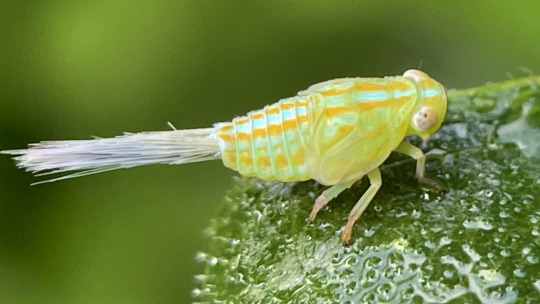
Aplos simplex, a member of the related family Issidae, also likes fig sap. its “tail” is actually a tuft of waxy secretions, which get shed along with the bright colors when it assumes a lumpy, bean-shaped adult form.
cicadellids, or leafhoppers, are just about everywhere on plants, but can be hard to approach without scaring them.


Agallia constricta on the left is a tiny species that feeds on grass, but many were scared up onto the fig by my footsteps. Jikradia olitoria is a much larger species that does feed on the fig; juveniles like this are curled, creeping goblins while adults’ rounded wings give them a pill-shaped appearance.

this big, pale leafhopper belongs to genus Gyponana. it’s tricky to get to species ID with these.
Graphocephala are striking little hoppers that eat a variety of native and nonnative plants. G. coccinea is the larger, more boldly colored one and G. versuta is smaller but more common locally. they’ll sit on the tops of leaves but take flight if you get too close quickly.
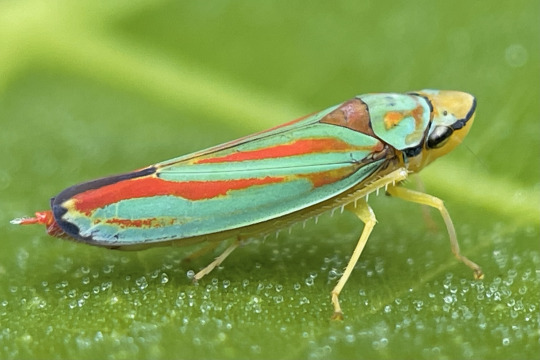
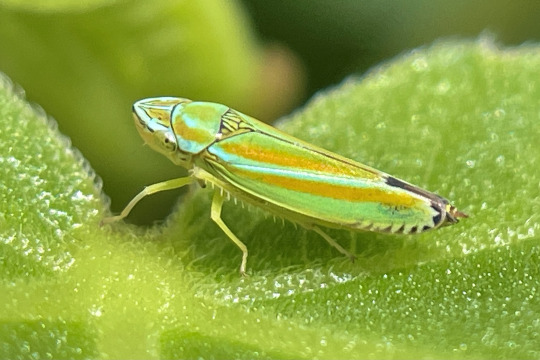
another group you’re almost guaranteed to encounter are flies (Diptera). these are a very diverse group, so much more than houseflies and mosquitoes (though I did run into both)
where I live, any plant with broad leaves is almost guaranteed to have a few Condylostylus, long-legged flies that come in shades of blue, green, and red. despite their dainty physique, they’re agile predators, typically feeding on other small flies.
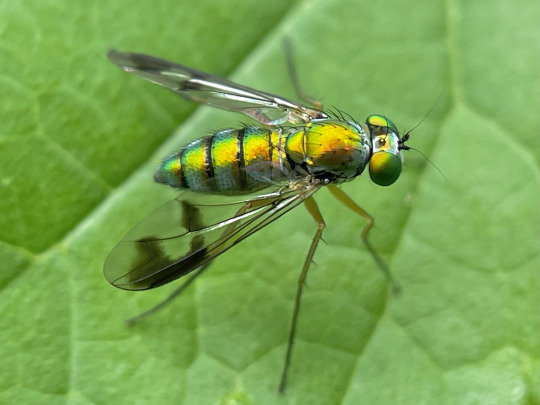
next, a few hoverflies: the ubiquitous Toxomerus geminatus and a Eumerus that I’ve been seeing a lot of this year (but maybe I’ve just noticed them for the first time). syrphids have varied life histories, but most adults drink nectar and many of the larvae are predaceous on aphids.
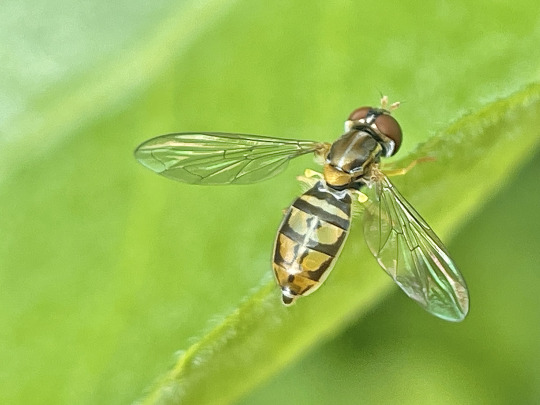
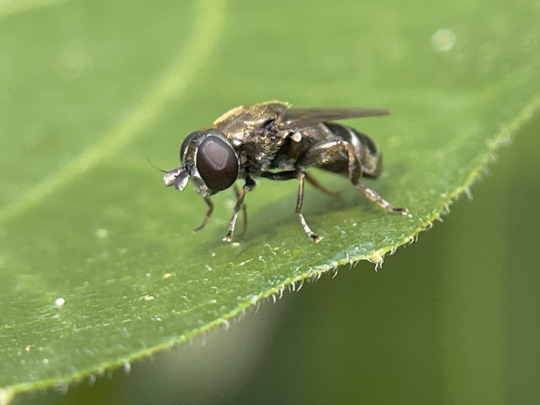
the metallic green soldier fly is Microchrysa flaviventris, nonnative here. Coenosia is a fun example of a “fly that looks like a fly,” with big red eyes and a gray body, and you might think they’re just another dung-sucking pest, but they’re actually aggressive predators! this one seemed to have nabbed itself some sort of nematoceran fly, maybe a fungus gnat.
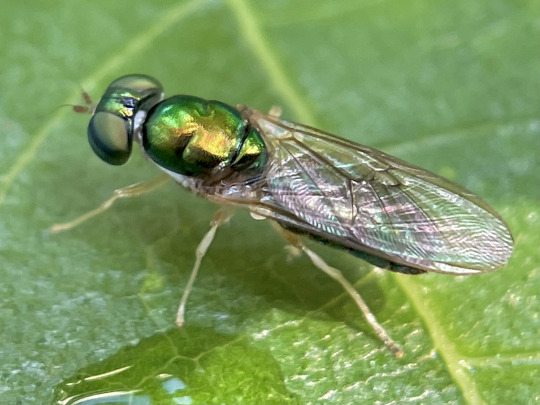

many flies are very tiny, just millimeters long. the first two little fellows are lauxaniids, while the last one, an agromyzid leafminer Cerodontha dorsalis, burrows through grass leaves as a larva.
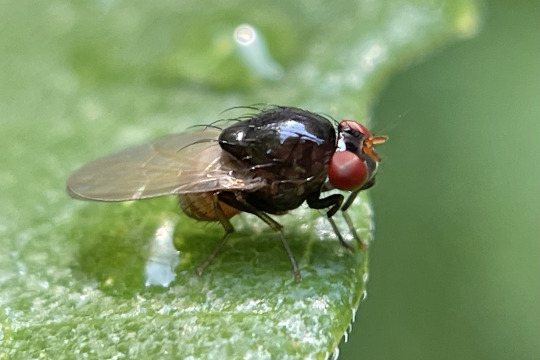
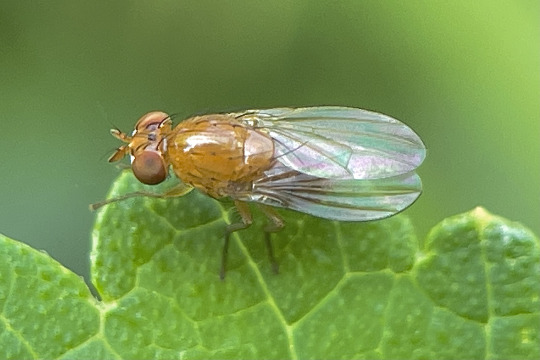

while moths and butterflies (Lepidoptera) are drawn to plants for their flowers or to lay eggs, many small moths can easily be found resting on or under leaves during the day.
these first two are tortricids, many of which are flat, rectangular moths resembling chips of bark or dead leaves. the apple bud moth, Platynota idaeusalis, feeds on a wide variety of hosts, while this beat-up old Argyrotaenia pinatubana would have developed in an edible tube nest of pine needles.


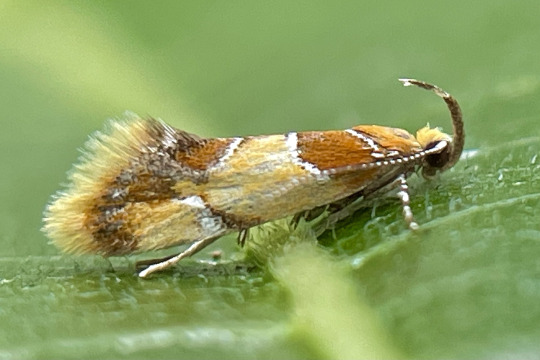
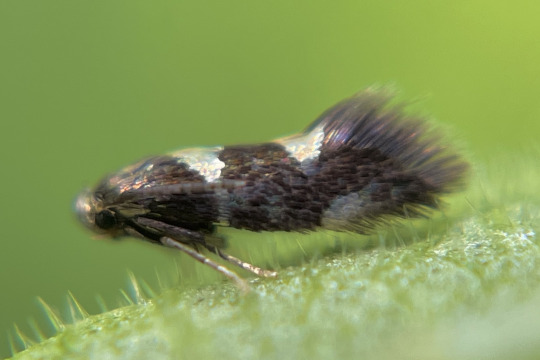
Callima argenticinctella feeds in bark and dead wood (a resource used by more caterpillars than you’d realize!) while the last moth, possibly an Aspilanta, is a leafminer.
although beetles (Coleoptera) are famous for their diversity, I didn’t find too many on the fig. the invasive Oriental beetle Exomala orientalis resting here can be found in a wide range of colors, from this common tan to to deep iridescent black. the other beetle is a Photinus pyralis firefly, sleeping under leaves as fireflies do.
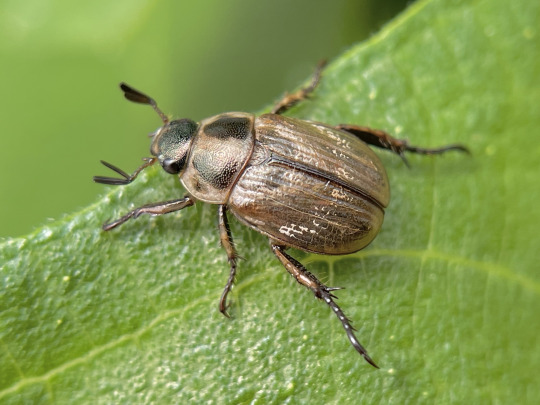

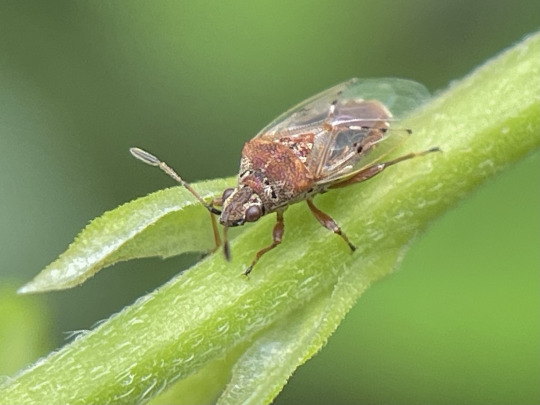
a few spare hemipterans: a Kleidocerys resedae that blew in on a wind, and below, the mulberry whitefly Tetraleurodes mori feeds on its namesake host. as for Hymenoptera, I saw manny tiny parasitic braconid wasps and various ants attracted to the planthoppers’ honeydew excretions—always worth checking underneath roosting hoppers for things having a drink.

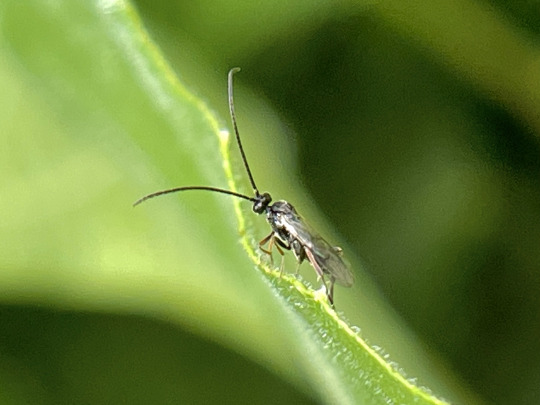
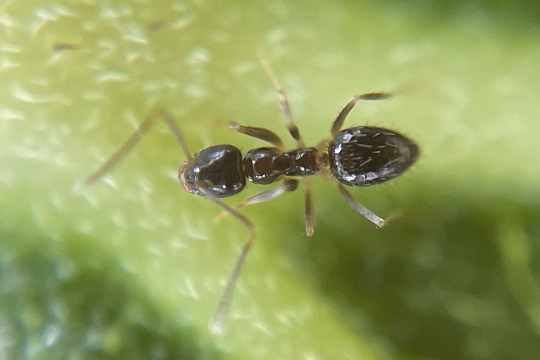
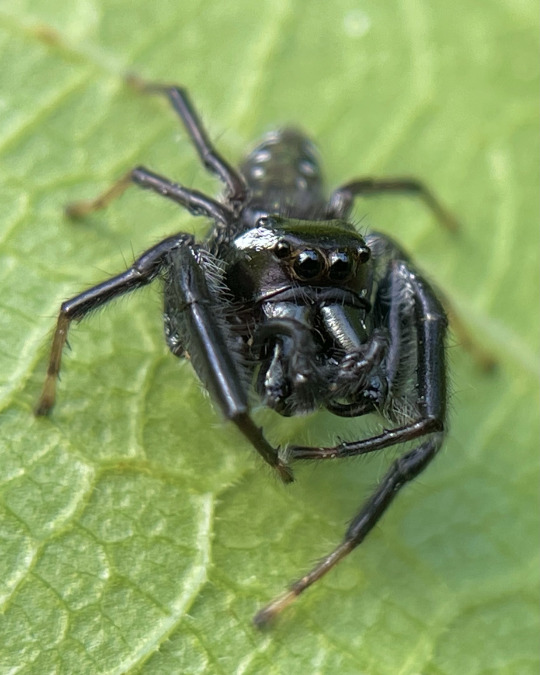
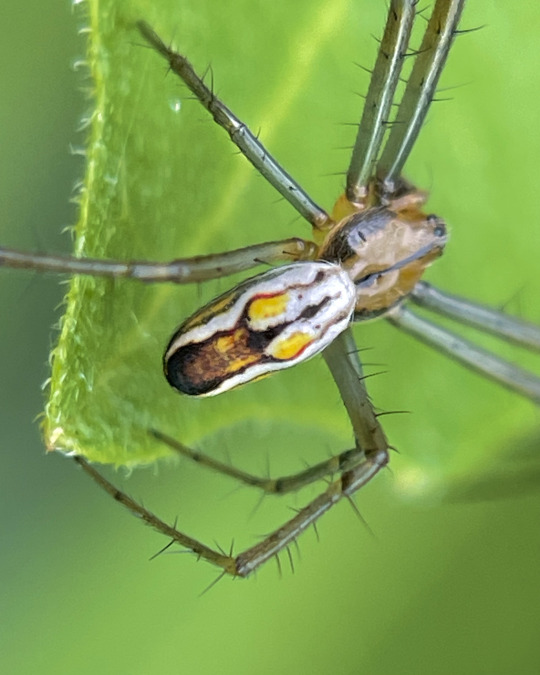
a couple handsome spider boys were scrambling through the fig seeking females, a jumping spider Paraphidippus aurantius and an orbweaver, Mecynogea lemniscata.
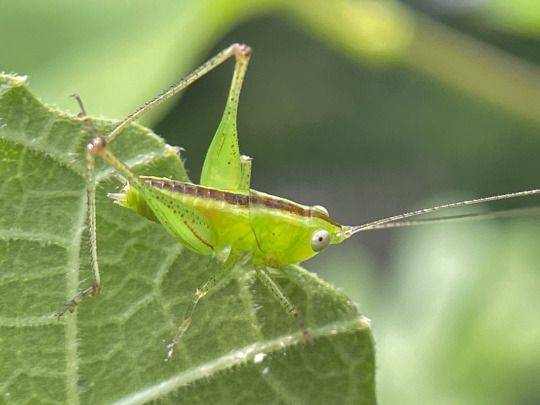
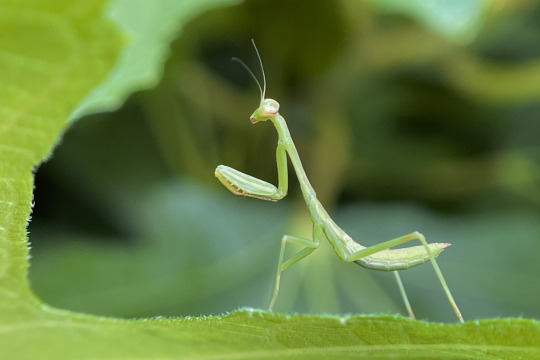
and to round it off, a young Conocephalus meadow katydid and a Carolina mantis, Stagmomantis carolina.
there’s 31 species of arthropod in this post, and I probably saw some 45, not all of which stayed for photos. if you walk slowly and look closely, you can see a sizeable chunk of your local biodiversity in under fifteen minutes! of course this will depend on where you live and what time of year it is, but there’s almost always more cool bugs out there than you’d expect, even on just a single plant.
1K notes
·
View notes
Text
*Frodo, high on Nazgûl voice* They're here...
(Condylostylus mundus are out and about now💙)
🌿

35 notes
·
View notes
Text

Condylostylus patibulatus, a type of long-legged fly, in Northeastern Pennsylvania.
#so shiny and chrome#flies are cool#diptera#fly#flies#bugs#nature#nature photography#biodiversity#animals#inaturalist#arthropods#bugblr#entomology#insect appreciation#insects#creature#pretty colors#metallic#shiny#invertebrates#biology nerd#macro#macro photography#Condylostylus patibulatus#condylostylus
40 notes
·
View notes
Text

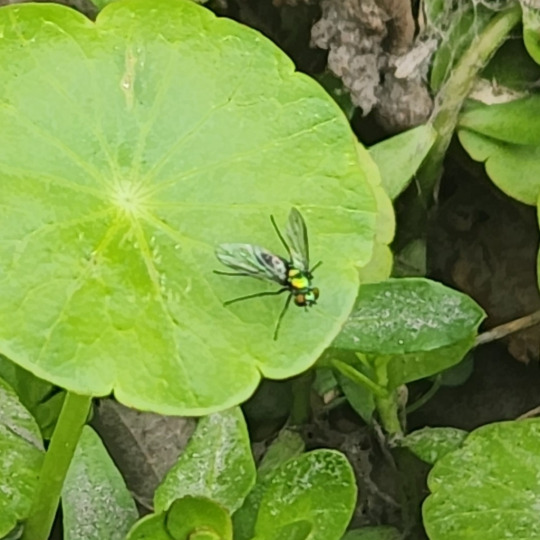

[ID: 3 up-close photos of Condylostylus flies perched on leaves. These flies are very small and are a shiny, yellow-green color. end ID]
I've been spotting a lot of long-legged flies (genus Condylostylus) recently! I love seeing these tiny guys, they're so pretty (if not a little hard to photograph, lol).
Did you know: Condylostylus flies have some of the fastest reflex times recorded from the entire animal kingdom! This may have developed because they spend a lot of time out in the open, which is great for finding mates but less great when it comes to attracting predators. (Sourakov, 2011)
Location: Brazos, TX.
#entomology#bugs#bug lovers#entomologists#insects#flies#bugblr#arthropods#invertabrates#bug photography
3 notes
·
View notes
Note
trick or treat :3

The very very VERY handsome Condylostylus mundus!! Such a gorgeous fly!
#vani verbals#these guys are almost purple in some lights. such pretty colors❤️❤️#the females are more green/yellow where the males are blue/purple#bugposting
7 notes
·
View notes
Text
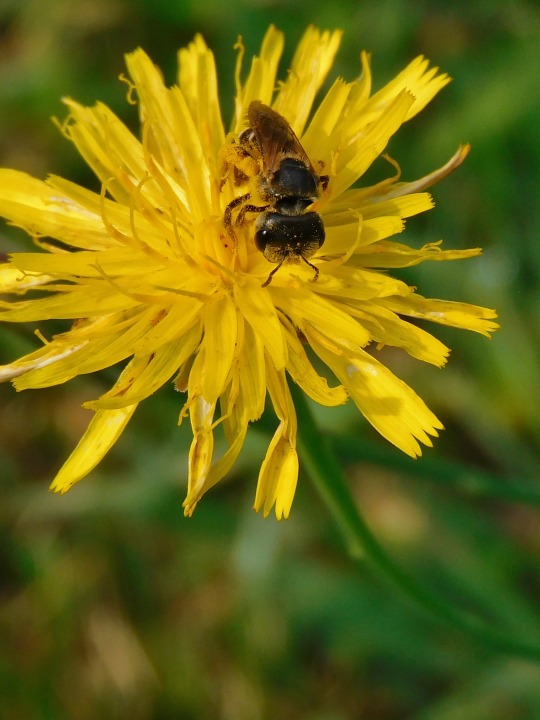


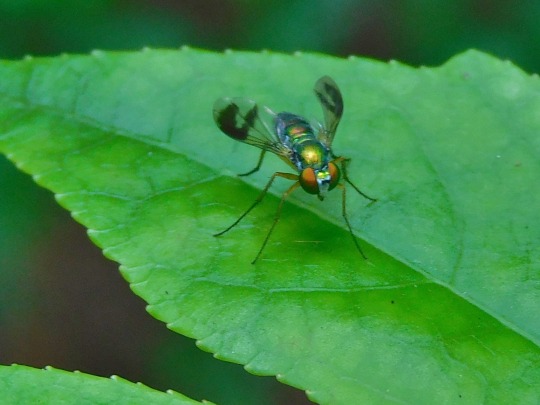
A few insecty/buggy/spidery thngs from this AM:
Ligated Furrow Bee (Halictus ligatus) as my best guesstimate...
Labyrinth Orbweaver spider (Metepeira labyrinthea) probably...
Long Legged Fly (Condylostylus spp.) of some variety...
#nature#my photography#nature photography#sweat bee#wildlife photography#arachnids#backyard nature#long legged fly#orbweaver#labyrinth orbweaver#pollinators
7 notes
·
View notes
Note
Bug delivery~
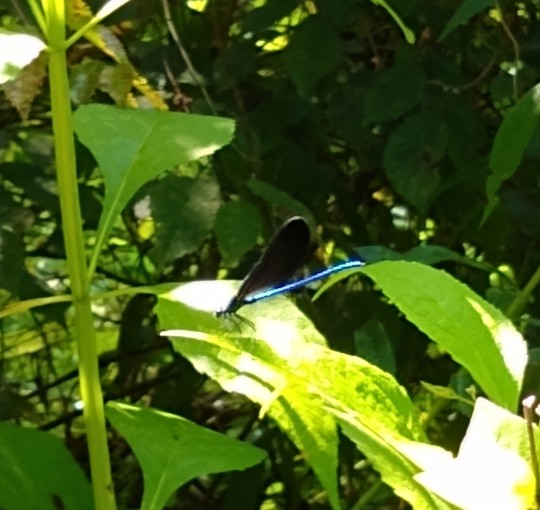
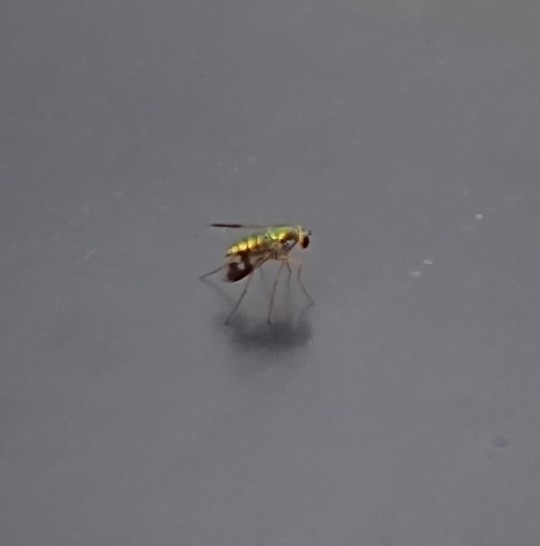

Ebony jewelwing damselfly, a tiny fly (maybe complex Condylostylus sipho), and a yellow-and-black flat millipede
BUG DELIVERY 💚💚💚
Officially tagging this ask series Bug Delivery now, thank you Flame, it's perfect
Oh my goodness these guys are so pretty!! My favorite of the bunch has to be the flat back, I have a big soft spot for millipedes. Not to mention that it's pattern is just oh so pretty
As for our flying companions, they're masters of colors in their own right OMGA. The damselfly is living up to it's name ten-fold 💚
I always loved the 'rainbow-like' qualities of bugs, but the way flies always has a flare to I can't quite describe
Also I meant to mention this before but I'm STILL 'embarrassed' that I mixed out that millipede from last time, hehe. Embarrassed in quotes because it was an honest mistake, I could only make out 1 leg per trunk. Oh the woes of not zoning in hehe
#bug#bug cw#Bug Delivery#flame-shadow#ask#Oh the darlings beasts now I cherish you#Also thanks for giving me the names of these guys!!#Now I know what names to research hehe
3 notes
·
View notes
Text
Big post of some of the flies I saw this year, starting with hoverflies:


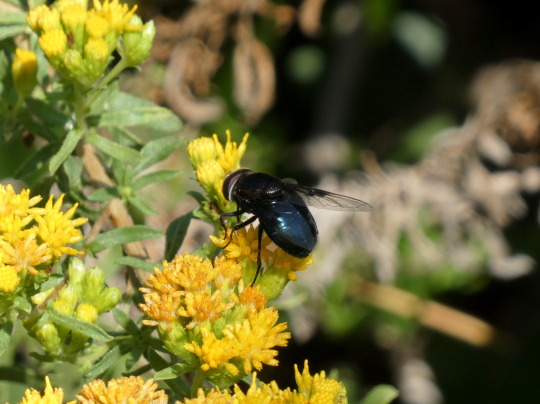





Eupeodes fumipennis, Dioprosopa clavata, Copestylum sp., Palpada alhambra, Paragus haemorrhous, Allograpta obliqua, Eupeodes volucris, Copestylum avidum
Next, bee flies:




Hemipenthes sinuosa, Villa lateralis, Aphoebantus interruptus, and …not sure
More fuzzy flies:




Ozodiceromyia sp., Thereva fucata, Mallophora fautrix, and some kind of robber fly
Big flies:
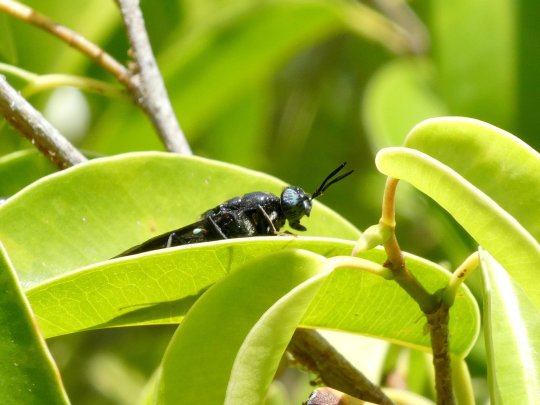

Hermetia illucens and some kind of crane fly
Smaller flies:


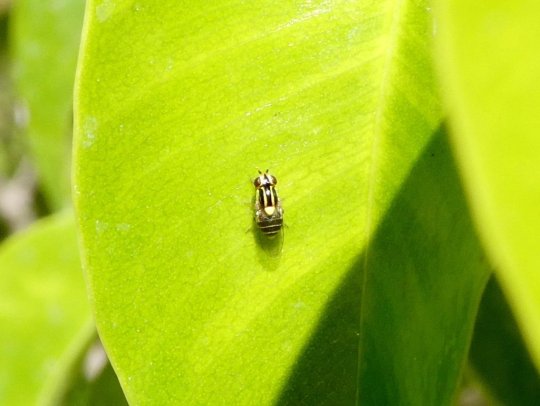



Leptopteromyia americana, Polyporivora sp., Thaumatomyia sp., some kind of lance fly, Condylostylus longicornis, Euparyphus sp.
#bugs#robber fly#hoverfly#flies#diptera#insects#photography#bee fly#soldier fly#entomology#invertefest
6 notes
·
View notes
Text




Condylostylus sp.
Some new, better photos of this gorgeous long legged fly
#flies#nature#insects#bugs#entomology#original photographers#condylostylus#sciapodinae#dolichopodidae#long legged fly#diptera#American species#my photos
8 notes
·
View notes
Text

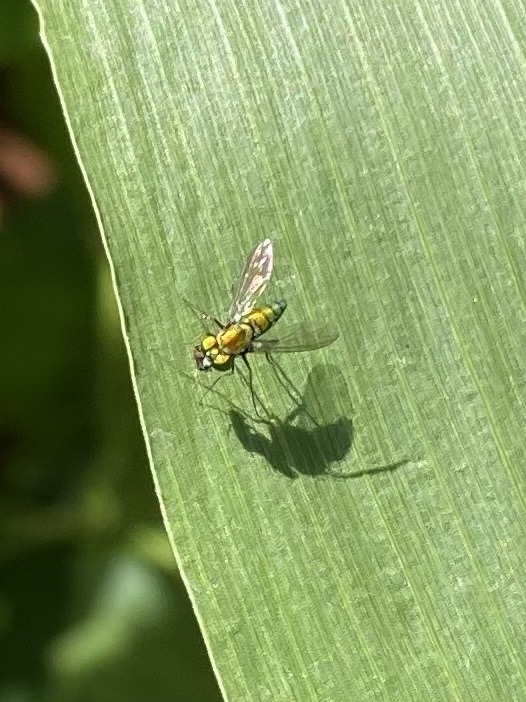
condylostylus sp.
2 notes
·
View notes
Text
Long Legged Flies are Pretty and Helpful
Long Legged Flies are Pretty and Helpful shows readers photos of one of Florida’s prettiest little flies. It also explains how useful these guys are and why they’re great to have around.
Golden Fly
Now that fall is here, the little long legged flies (Condylostylus patibulatus) have returned. I had never seen them before last year and I thought it might have been because last year was pretty wet. But this year has been unusually dry and they’re still here, so I guess I have to chalk it up to my never noticing before. They are pretty small, and although they aren’t shy, they don’t…
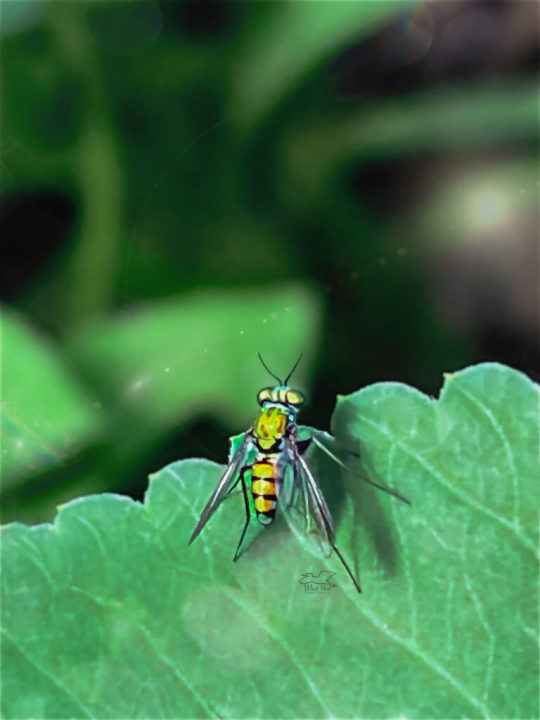
View On WordPress
#beautiful flies#beautiful insects#colorful flies#colorful insects#fall flies#fall insects#Florida flies#Florida insects#fly photographs#flying insects#helpful insects#insect photographs#insect photography#insects#long legged flies#macro photographs#macro photography#photography#small flies
0 notes
Text
I love it when someone adds a Species Complex identification to one of my observations. Like oh good, so there was absolutely no chance of me identifying that correctly anyway.
for those who don't know, here's from the wikipedia page:
In biology, a species complex is a group of closely related organisms that are so similar in appearance and other features that the boundaries between them are often unclear. The taxa in the complex may be able to hybridize readily with each other, further blurring any distinctions.
I know this is also a thing with I think ratsnakes, where there's more than one species that all looks indistinguishable.
this time it was for a tiny bright orange metallic fly I was lucky enough to get a picture of! Complex Condylostylus comatus
1 note
·
View note
Photo

Please welcome the longlegged fly to this week's episode of Disney Diptera. 🍃 🌱 🌿 #wdw #waltdisneyworld #explorida #roamflorida #igdisney #igers_wdw #igersflorida #orlando #depthoffield #igersorlando #pureflorida #disney #disneygram #disneyparks #disneyworld #florida #fun_in_florida #LoveFL #macro #nature #entomology #diptera #fly #longleggedfly #green #condylostylus #macroworld #macro_captures #macro_perfection (at EPCOT) https://www.instagram.com/p/BhbxT5AA70b/?igshid=NGJjMDIxMWI=
#wdw#waltdisneyworld#explorida#roamflorida#igdisney#igers_wdw#igersflorida#orlando#depthoffield#igersorlando#pureflorida#disney#disneygram#disneyparks#disneyworld#florida#fun_in_florida#lovefl#macro#nature#entomology#diptera#fly#longleggedfly#green#condylostylus#macroworld#macro_captures#macro_perfection
0 notes